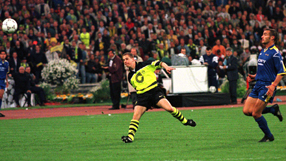Germany reaping benefits of youth regime
DORTMUND - Champions League winner Lars Ricken looks a proud man as he walks through Borussia Dortmund's state-of-the-art youth training centre.

Pitches, weight rooms and treatment facilities abound in this complex, nestled in a leafy area of the Ruhr valley city and dedicated to young players.
"When I was growing up I did not have access to this," said Ricken, one of the club greats who scored in the 1997 Champions League final to help Borussia win the trophy. He is now the club's youth coordinator.
"You cannot compare this with 20 years ago," he told Reuters during a tour of the centre.
The academy, which includes a boarding house for the most talented youth players, is one of 36 of its kind in Germany as all Bundesliga and second Bundesliga clubs must have one.
They are largely responsible for producing Germany's dazzling and young World Cup team, who finished third in the tournament in South Africa in July.
Nineteen of the country's 23 World Cup players were a product of the clubs' youth academies and the squad's average age was less than 24 years and nine months.
Players such as Thomas Mueller, Mesut Ozil, Sami Khedira, Jerome Boateng, Holger Badstuber and keeper Manuel Neuer, who are now household names worth millions of euros, emerged from this system.
Get FourFourTwo Newsletter
The best features, fun and footballing quizzes, straight to your inbox every week.
"The need to introduce a uniform obligatory youth training system emerged after Germany's disastrous 1998 World Cup and Euro 2000," Reinhard Rauball, president of the German soccer league (DFL), which runs the top two divisions, said over a light lunch.
"We said we have to do something so that we never have such results again."
LICENCE REQUIREMENT
From July 2002 the youth academies became a requirement for clubs wishing to obtain a licence for either of the top two divisions.
Since then more than half a billion euros have been poured into the system, 83 million euros last season alone.
The youth academies must follow strict guidelines including having a specified number of floodlit pitches, teams with a set number of players, qualified coaches and scouts. They must also have a clearly defined philosophy.
"We play systems of 4-2-3-1 or 4-3-3," said Ricken. "Basic attacking football and always going forward."
It is no coincidence that this is also Germany's favoured system.
"It is a system that is very popular and can be morphed into any other system," Ricken said.
Since 2002 the academies have fed clubs with hundreds of players. Three years ago 88 Bundesliga and 56 Bundesliga 2 players came from the academies.
This season the figures have risen to 110 and 88 respectively, representing 20 percent of all first and second division players or one in five players.
The programme has also been an overwhelming success for the national teams.
Every Germany under-21 player last season was a product of the academies, and 21 players out of the 24 in the U20 team.
TRANSFER MONEY
Borussia built their new academy
